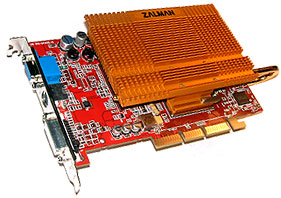
TOP 5 Heat Sinks TOP 5 Low Profile Heat Sinks TOP 5 Liquid Coolers
Heatsinks by Brand / Mfgr Reviews + Articless Advanced Search
 |
TOP 5 Heat Sinks TOP 5 Low Profile Heat Sinks TOP 5 Liquid Coolers Heatsinks by Brand / Mfgr Reviews + Articless Advanced Search |
As a general rule, we prefer to test cooling devices on a synthetic test bed, but sometimes that just isn't possible. To test out the Zalman ZM80A-HP we've enlisted the help of a Crucial Radeon 9700 since it is the card most likely to be used with this VGA cooler. Testing on the nVidia platform was care of an Albatron Ti4600.
This might seem a little odd at first as the instinct of most people would be to place it directly above the requisite GPU cores, or just adjacent to them. After factoring in the option of drilling tiny little holes for the type-K thermocouple everywhere, and the multitude of stock heatsinks we would be contending with, not to mention differing types of BGA packages, simplicity reigned supreme. Throughout this series of reviews on videocard BGA coolers, we will be taking temperature measurements with a Type-K thermocouple placed directly behind the core, effectively measuring the temperature of that small patch of PCB. The thermocouple is insulated against the surrounding environment with a small section of closed-cell foam. The foam helps to ensure that the thermocouple stays put, and isn't cooled off by exhaust air eminating from the processors' heatsink, case fans, or any other transient sources. To generate some heat in the actual GPU, we found that running 3DMark2001 three or four times in a row nets fairly consistent results, though different GPU's react differently to the tests which is quite interesting. We've also included a set of results with a 4000RPM 92mm case fan blowing in the direction of the Zalman ZM80A-HP (simulating a front case fan which is common on most computer enclosures) from five inches away. This fan does create a small amount of noise, but as the ZM80A-HP does not ship with any fans, the results are mainly intended as an example of what active cooling could bring to the table.
The final temperature results look like this; with the stock cooler, the ATI Radeon 9700 is measured at about 48.1C, and with the passively cooled Zalman ZM80A-HP that temperature rises to 58.5C. The ZM80A-HP in this configuration is absolutely silent, but the temperatures may be a little high for some people's tastes. We ran the card through some standard sets of benchmarks and everything functioned normally, so there were no issues with stability we are aware of. The really plus to Zalman's technology comes with the addition of just a little bit of airflow from a 92mm case fan. We tested this out with a fan was positioned at the front of a chassis, with airflow directed up towards the AGP slot. The noise created by the 92mm case fan (same type used with Zalman's CNPS6500B heatsink) was under 40dB, but the measured temperature dropped down to about 41.5C - lower then that of the stock ATI heatsink.  In testing with an Albatron GeForce4 Ti4600 we saw similar trends; with the Zalman ZM80A-HP the temperatures rose to 62.4C over 54.8C for the stock active heatsink. With the addition of a little airflow directed from a low noise case fan the temperature dropped down to 52.9C - lower than that of the stock cooling solution. There are two ways to look at the Zalman ZM80A-HP; first as a totally silent VGA cooler for systems with good passive cooling, and secondly as a passive cooling solution for use with a little active case cooling. The second is not necessarily outlined in the manual, but with a bit of 'bodging' we were able to net a positive temperature improvement from a very unique VGA cooling solution intended primarily to be silent. A cool product that would be well worth considering if your computer's VGA fan is making too much of a racket. Silence is golden, and in this case I guess that really is true. ;-)
|
|
||||||||||||||||||||||||||||||||||||||||||||||||||||||||||||||||||
|
Find a Heatsink . Latest Heatsink Reviews . Top 5 Heatsinks Tested . Top 5 Low Profile Heatsinks . Top 5 Liquid Coolers . Heatsinks by Mfgr / Brand |
Social Media |
FrostyTech.com Info . Feedback . Contact Us / Heatsink Submissions . Submit News . Privacy Policy |
 | |
© Copyright 1999-2025 www.frostytech.com All Rights Reserved. Privacy policy and Terms of Use Images © FrostyTech.com and may not be reproduced without express written permission. Current students and faculty of accredited Universities may use Frostytech images in research papers and thesis, provided each image is attributed. | ||||